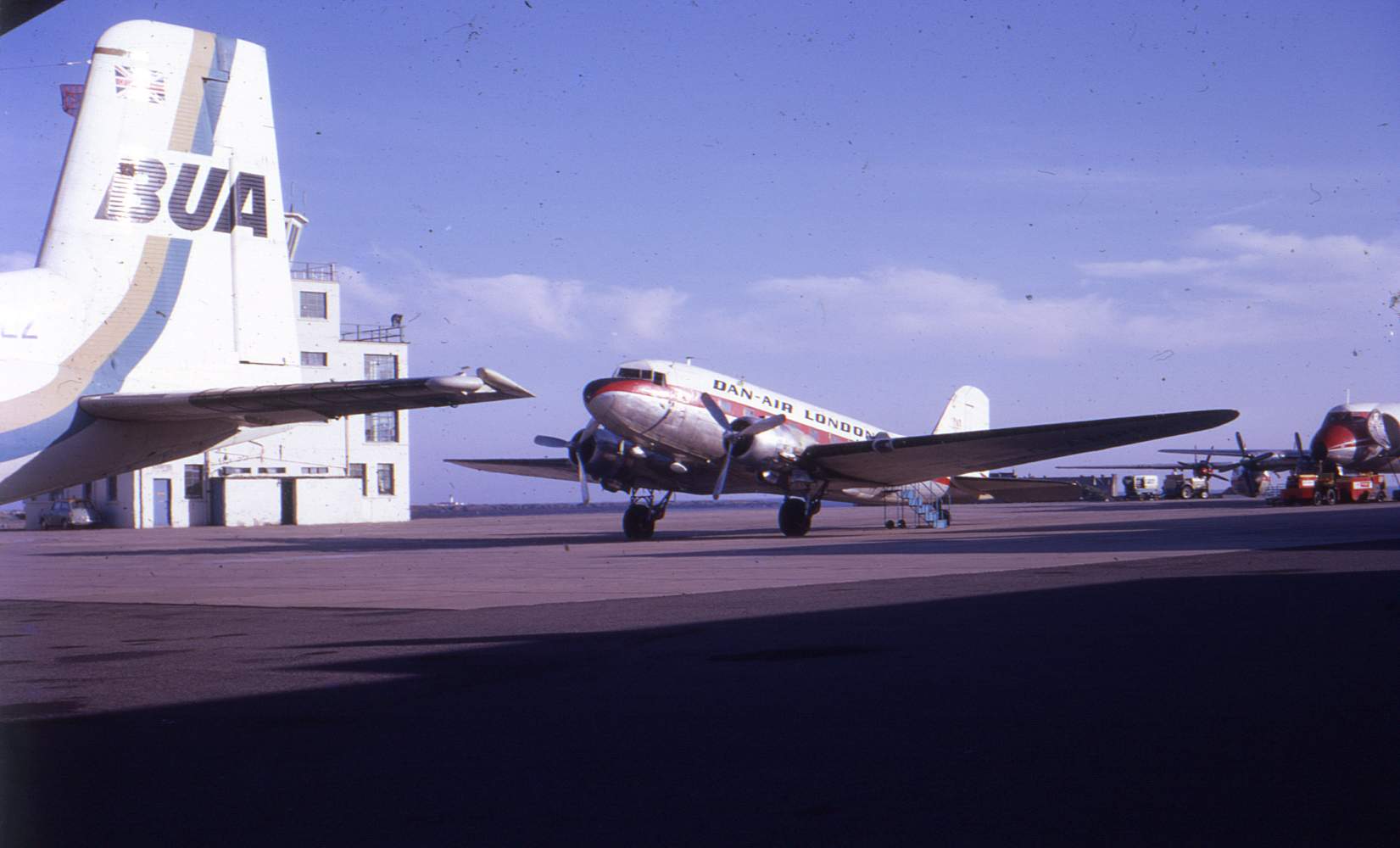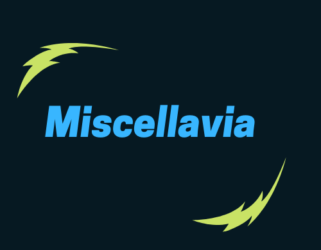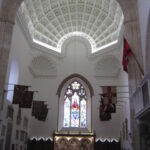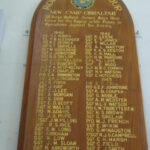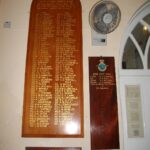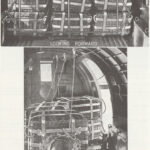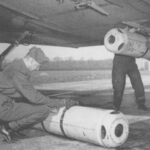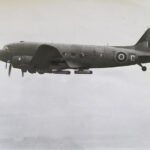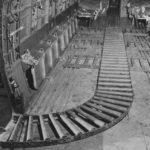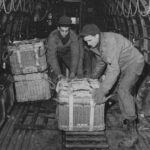
As a child, I was always fascinated by photographs my father had taken when flying with 233 squadron in the Far East at the end of WW2. Small black and white prints showed dusty Dakotas being loaded with sacks of rice at airfields in India and Burma: Imphal, Mingladon, Tulihal, Lashio, Myitkyina. Fabulous names, charismatic aircraft, demanding missions ranging from the border with China to the Golden States of Shan.
In later years, I met with one of my father’s friends and colleagues who had flown with 233 squadron in India. He had also been a navigator with the squadron on earlier european missions following D-Day and during the traumatic Market Garden campaign. He lent me his log books which I assiduously copied in great detail. I soon discovered that the aircraft he had flown in at Arnhem had survived, despite extensive damage, and had gone on to have a distinguished career in British civil aviation. FZ681 had become G-AGYZ of Skyways and, almost thirty years after Arnhem, continued to fly on freight services between Kent and Europe.
Skyways and Air Freight were later kind enough to arrange for me to fly on G-AGYZ and, subsequently, work as a freight loader for the airline. I have recently expanded my researches into this fascinating squadron and its illustrious history. Much of the detail from the Second World War comes from the Squadron’s diaries and operational logs accessed via the National Archives as well as personal log books. The missions of FZ681 have been used to exemplify the Squadron’s operations in Europe from 1944 prior to the 1945 departure for the Far East.
Note: I have cheekily misappropriated a copy of the squadron badge from the eBay site of: Family Crests, Unit 3 Roddy’s Retreat, Pier Road, Pembroke Dock, Pembrokeshire, SA72 6TR. I trust the advertisement will go some way to offset copyright infringements!
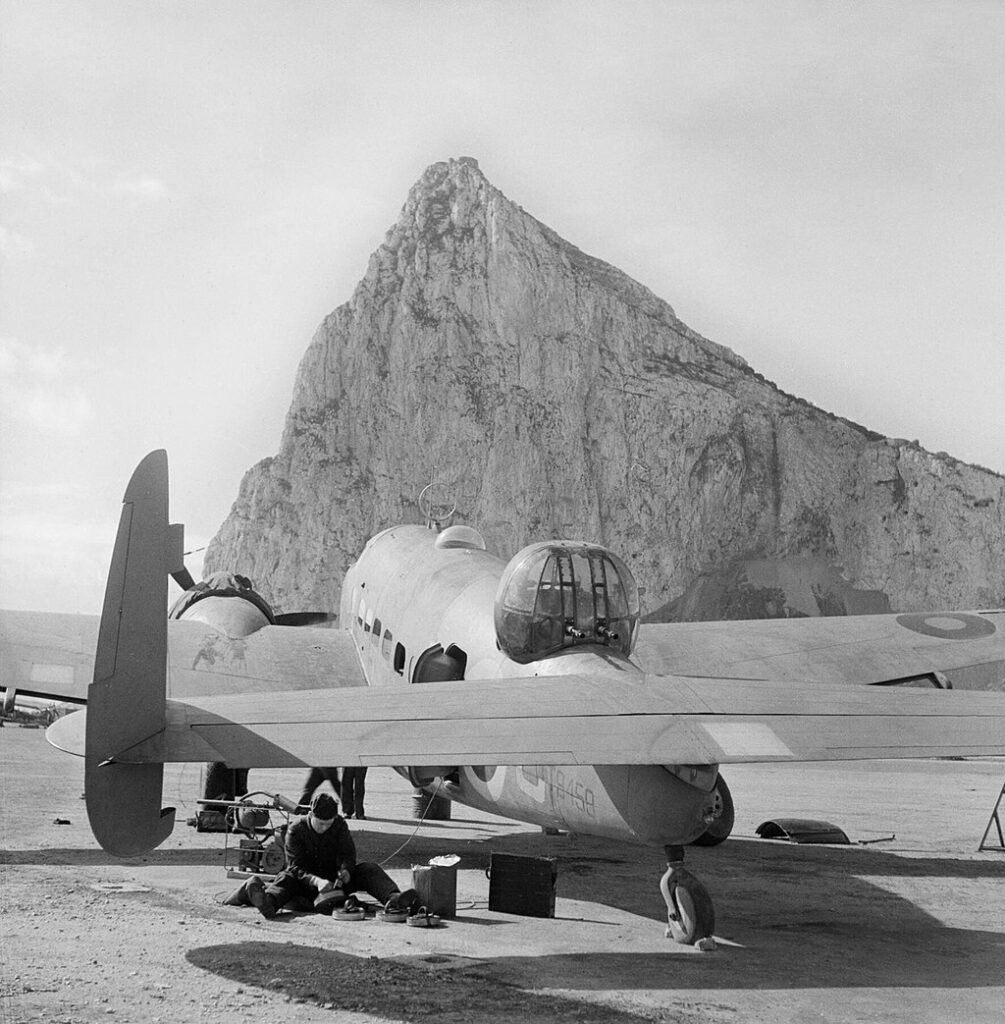
Early History.
233 Squadron had a long and illustrious history, initially being formed during the First World War by the amalgamation of three Royal Naval Air Service flights into a single squadron. 233’s early complement contained a diverse range of aircraft from Sopwith Camels and DH.9s to Short 184 flying boats. The seaplanes operated from a station below Dover Castle and they were tasked with protecting shipping in the English Channel as part of the ‘Dover Patrol’. Disbanded on 15th May 1919, it was not until new war clouds were building in 1937 that 233 re-emerged, this time at Tangmere, but still with a marine reconnaissance bias.
Initially equipped with Avro Anson 1 aircraft, their operational base moved north to RAF Leuchars in Fife in August 1939. The new location coincided with an upgrade to Lockheed Hudson Mk1 aircraft to facilitate shipping sweeps over the North Atlantic and, in this role, around 130 missions were flown each month. Their function assumed greater significance in April 1940 when Nazi forces invaded Norway. The Hudsons, by now equipped with radar, briefly moved to Aldergrove, Northern Ireland, in August 1940 to provide extra cover for the convoys operating to and from Liverpool and Glasgow. After only a month, 233 returned to Leuchars and North Sea/ Baltic patrol duties but, by December 1940, they were back at Aldergrove. The squadron was able to report several attacks on U-boats and Luftwaffe aircraft before they moved south to St.Eval in Cornwall in August 1941. Their new zone of operations became the Bay of Biscay and life was more hectic here. Attacks were made on four U-boats and one Hudson was lost. An even more demanding move was scheduled and, in September 1941 under the command of Squadron Leader Davey, they began to move aircraft to Gibraltar. Their new patrol area was centred on the Straits of Gibraltar and the Portuguese coast and, during November 1941, 6 U-boats were attacked by 233 Squadron Hudsons. The docks at St.Nazaire were also attacked, but possibly by aircraft still based in mainland Britain. The facilities at Gibraltar’s North Front airstrip were primitive with only one or two patrols a day possible. Landing conditions exacting a brutal toll on Hudson undercarriages and the squadron was on the cusp of being recalled to Britain. However, in view of their contribution to protecting convoys bound through the Straits of Gibraltar, a major improvement to facilities was authorised. Gibraltar’s first resident RAF squadron was to have a proper runway built for it!
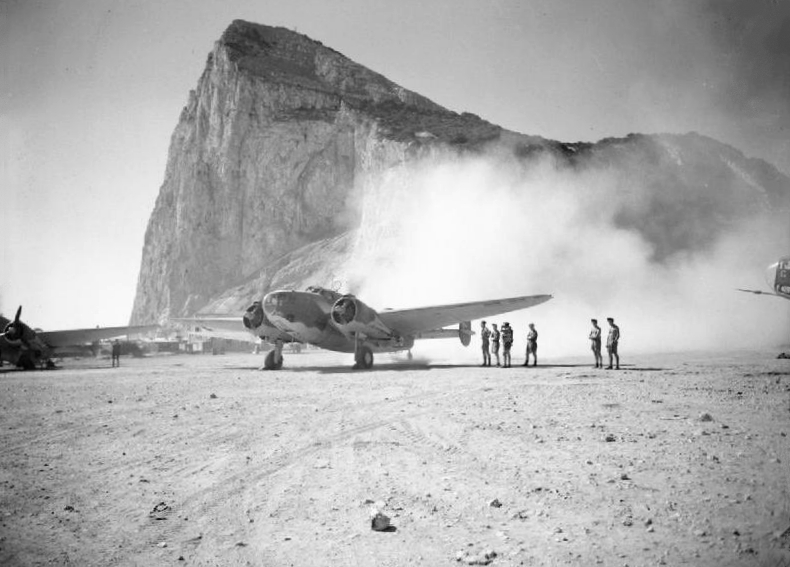
In view of the restricted facilities on the Rock, 233 Squadron would operate a maintenance base at Gosport, Hampshire, to service the 15-20 Hudsons based at North Front on a rotational basis. Indeed, the rump of the Squadron had already moved from St. Eval to Gosport. The benefits of the improvements soon accrued and four U-boat scalps were claimed during 1942 and 1943 with two of the Luftwaffe’s long range Condors also destroyed. The Squadron’s zone of influence extended as far south as the Canary Islands and they also supported Operation Torch across the water in North Africa during November 1942. From October 1943 to February 1944, a detachment of 233 Squadron was moved to the Azores in order to extend the fight against the U-boats. However, the submarine scourge was fading and, in view of the imminent allied landings in Europe, 233 Squadron was moved back to Britain ready for reconfiguration as a Transport Command squadron. Their time in Gibraltar was celebrated by the issue in 2014 of the £2 stamp in the RAF Squadrons in Gibraltar commemorative set.
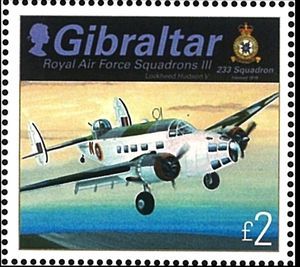
The Squadron’s stay on Gibraltar is also commemorated in King’s Chapel where there is a roll of honour and a plaque dedicated to the crew of 233 Hudson FH453, lost on November 8th 1942. This was one of six aircraft which failed to return that month, many believed to be the victim of ‘friendly fire’ from US Navy F4Fs during Operation Torch. The 26-year old captain was Flying Officer Harry Lethbridge, a native of Perth, Western Australia.

The advance party departed Gibraltar on February 21st 1944 heading back to 233’s UK base of Gosport via Portreath in Cornwall. Elements of the squadron were initially re-united at Bircham Newton in Norfolk from February 23rd onwards. Bircham had hosted Coastal Command Hudsons for some time but it was never going to be more than a staging point for the Transport Command incarnation of 233 Squadron and a new airfield was under construction for them at Blakehill Farm in Wiltshire. While senior staff visited Blakehill to ascertain progress on 25th February, a large part of the squadron had still not departed Gibraltar.
Blakehill Farm was one of three airfields constructed during 1943 along the edge of the rolling limestone hills of the Cotswolds. Although two out of the three were built to accommodate the USAAF, by February 1944 they had all been assigned to Transport Command and their names would become permanently associated with WW2 Dakota and glider operations: Down Ampney, Blakehill Farm and Broadwell.
Blakehill was a 580 acre development which absorbed two farms near Cricklade in Wiltshire (1) and groundwork commenced in May 1943 with a view to the airfield being ready for the invasion of Europe in late spring of the following year. Concrete pouring was underway by August 1943 as is evidenced by dated ‘signatures’ which were inscribed in the wet cement and remain visible today. The Cotswold airfields formed part of a group dedicated to the airborne forces operations of the US 9th Air Force and RAF Transport Command and were constructed with a limited expected life span. Blakehill Farm was a product of its time with three concrete runways and fifty ‘spectacle’ dispersal pans offering efficient parking for a large number of aircraft. The opening-up crew arrived in February 1944 and found progress to be slightly behind schedule. Facilities at the airfield were to be minimal anyway, but the accommodation was incomplete and large crews of temporary labour were still hard at work under the control of George Wimpey Ltd. Runways consisted of a layer of Cotswold limestone overlaid with a thin (sometimes too thin!) layer of concrete. The ‘A’ pattern of runways comprised the main 2000 yard strip plus two auxiliary 1470 yard runways. One hundred yard extensions were constructed to facilitate connecting-up gliders and tow aircraft. Two corrugated steel T2 hangars were provided for more serious levels of Dakota servicing. A glider dispersal field was delineated on the western edge of the airfield on the ‘100 acres’ which had originally been an area of allotments. Later in 1944, airmen would find this a convenient route from the airfield to the Foresters Arms pub in Leigh village. The medical centre, of significance when 233 Squadron began casualty evacuation following D-Day, was located at a site on Malmesbury Road.
References:
(1) Details of Blakehill Farm’s development can be found in Bob Clarke’s informative book ‘Archaeology of Airfields’ published in 2008 by Tempus Publishing. The website www.rafblakehillfarm.co.uk compiled by Vince Tovey, today a warden for Wiltshire Wildlife Trust at Blakehill, provides an excellent and comprehensive history of the airfield.
http://www.historyofwar.org/air/units/RAF/233_wwII.html
https://www.bbc.co.uk/history/ww2peopleswar/stories/20/a5645720.shtml#top.
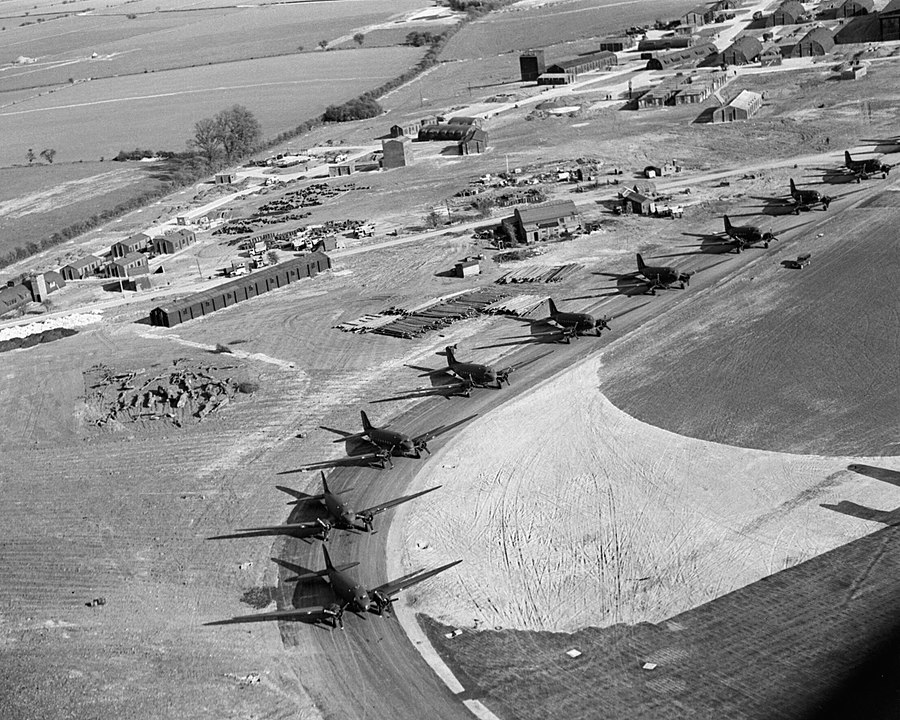
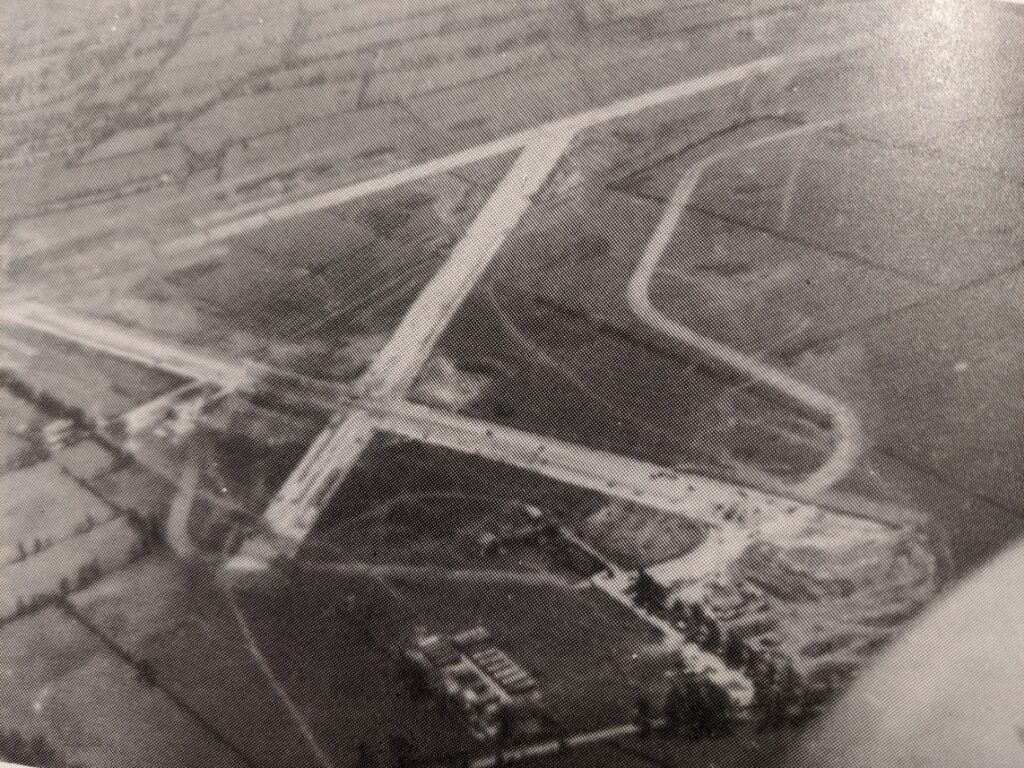
Dakota deliveries for 233 Squadron – the run-up to D-Day.
While Blakehill Farm was being constructed, 233’s complement of new Lend/ Lease Dakotas was being assembled at RAF Montreal, Dorval airfield, in Canada ready for the Atlantic crossing to Northern Ireland or Prestwick, Scotland. The RAF had formed the Atlantic Ferry Organisation in July 1940 and, in November of that year, the brilliant Australian aviator Captain Don Bennett (2) led seven Hudsons from Gander to Aldergrove on the first ferry operation. Presumably, prior to that, aircraft from the USA, including 233 Squadron’s early Hudsons, had been delivered by ship. On July 20th 1941 RAF Ferry Command was formed and maintained this identity until 25th March 1943 when it was absorbed into Transport Command and assigned Group status. The contribution of the ferry pilots is hard to over-exaggerate as, prior to their operations, only around 100 aircraft had attempted the North Atlantic route. Most of these flights had been in summer and, with primitive aircraft and celestial navigation alone, only around half completed the journey.
The first Dakotas began to arrive at Dorval from early February 1944 (3) with FZ669, FZ679, KG313, KG329, KG356, KG399, KG400 and KG410 arriving by February 10th. The duration of the crossings varied with weather but it took, from arrival in Montreal to touchdown in the United Kingdom, around three weeks for this first batch. A further one to three weeks generally elapsed before each aircraft was received by the Squadron. Individual aircraft histories – e.g. G-AGYX (4) – show that Dakota IIIs were being prepared at Gosport from the end of February 1944. FZ669 and KG329 from the first consignment are recorded with 233 Squadron on 29th February along with KG315, KG403, KG420, KG427, KG433, KG437, KG441 and KG448. The latter eight Dakotas had arrived in Canada between 13th and 16th February and may have benefited from slightly better weather on the ‘Blue Spruce Route’as they seem to have taken 7-10 days to reach the UK. If the dates are reliable, KG433 had a particularly swift transit, arriving in the UK in a suspiciously short 3 days and reaching 233 Squadron a mere five days later. Following preparation at Gosport, the first Dakotas were flown to Bircham Newton during the first few days of March. The main party of 233 Squadron transferred to Blakehill on March 5th and 12 Dakotas landed on March 7th ready for conversion training which commenced the following day (5).
A batch of 13 aircraft arrived in Montreal between 20th and 24th February 1944 and most of these were with 233 Squadron by mid-March (6). Training and conversion proceeded apace although, by May 1944, many of the Squadron’s new crews would be at Operational Training Units such as 107 OTU which had been established at Leicester East in order to train Dakota and Horsa glider crews. The exercises were, predictably, geared towards the forthcoming invasion of Europe with glider towing, paratroop operations and pannier dropping. On April 2nd, Squadron aircraft picked up gliders from North Luffenham and also took part in pannier dropping exercises at Netheravon (7). On 6th April, gliders were picked-up from the grass strip at Swanton Morley in Norfolk. Cross-country flying and navigational exercises were carried-out by day and night. Flying in the 3-aircraft Vic formation was practised on 7th April and night-time glider towing on 10th April. 120 troops were dropped close to Stonehenge during an exercise on 13th April and a further 360 troops of 2nd Division were involved in a similar exercise on 17th. Between 18th and 22nd April, 233 Squadron aircraft were back at North Luffenham for glider towing practice. Cross-country glider towing was practised on 23rd April and, three days later, the Squadron had its first ‘live’ mission with three aircraft heading to Northern France on a leaflet dropping (‘nickelling’) mission. Caen was the target for this operation which was successfully carried out by KG341, FZ678 and KG340 on the night of April 26th. This was repeated the following night with Alencon the target for the propaganda leaflets. FZ685 and FZ686 completed the project but FZ681, flown by Flt.Lt.A.Cody, developed a radar fault after crossing the English coast at Shoreham and had to turn back.
(2) For the fascinating life story of Don Bennett, readers are recommended to start with the biographies section of www.rafweb.org. Post-war he became a director of British South American Airways and, subsequently, purchased Blackbushe Airport when it was demobilised.
(3) Delivery dates are taken from JMG Gradidge’s excellent Air Britain book, The DC-3 and its Predecessors’.
(4) A history of G-AMWX can be found at www.rafmuseum.org.uk/documents/collections/X002-9932-DOUGLAS-C47.pdf
(5) Information from the official Squadron Operations Log for March 1944 doesn’t seem to be available in the National Archives yet; the list is taken from Air Britain’s DC-3 and its Predecessors. The aircraft were probably FZ669, KG313, KG315, KG329, KG351, KG403, KG420, KG427, KG433, KG437, KG441 and KG448. KG313 survived the war to become G-AHCT, an aircraft which will appear in more detail in another thread.
(6) FZ678 arrived at Dorval on 20/2/44 and was with 233 Squadron on 18th March while FZ666, FZ688, KG341, KG429, KG430 and KG433 arrived in Canada on 21/2/44. FZ681, FZ685, FZ686 and KG455 arrived at Dorval on Feb. 24th, KG447 the day before.
(7) Squadron Operations Logs accessed via National Archive.
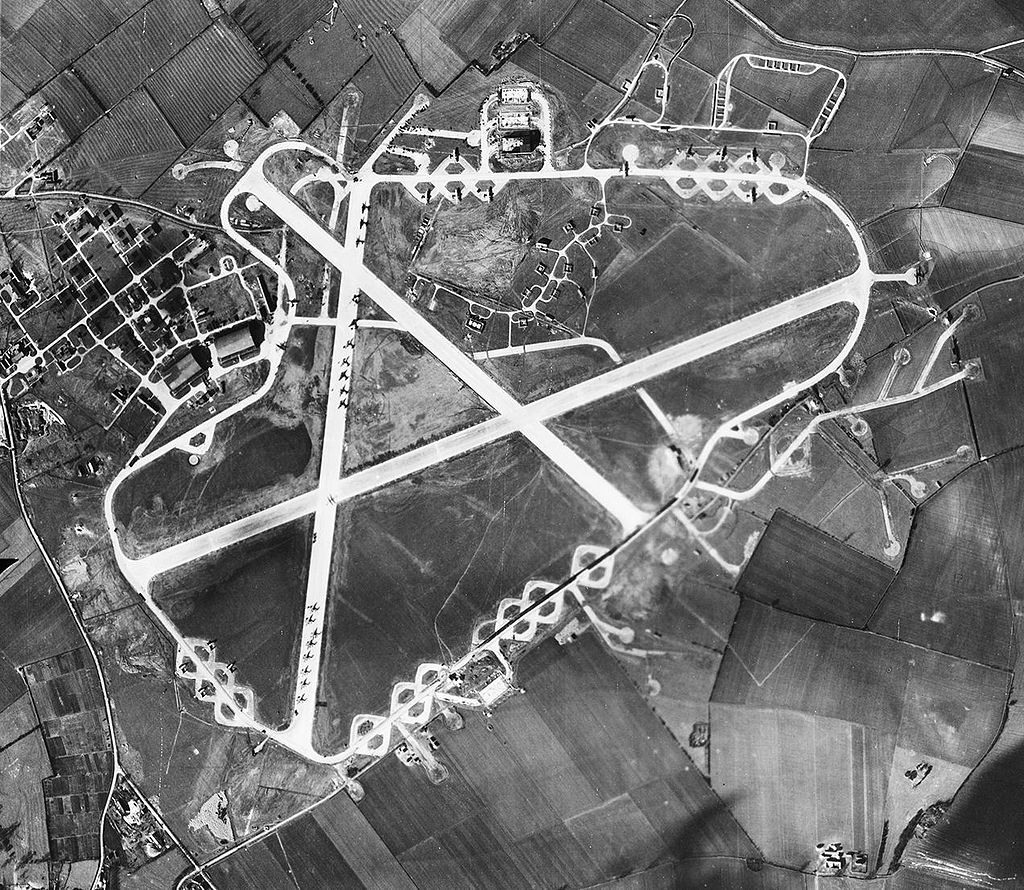
Early May, 1st and 2nd, saw 233 Squadron back to glider towing exercises after a Searchlight evasion practice on the last night of April. Troops of the 1st Polish Air Division joined the Squadron for exercises on 3rd May, 7th May and 9th May (2nd Polish). On 5th May, container dropping was completed with troops from Down Ampney airfield. Between May 10th and 20th, glider towing operations included night exercises. Some of the flights, for example May 21st and 22nd, involved quite long distance routes from Blakehill and Netheravon, south-west to Lands End, north to the Isle of Man and then back to base. From 23rd May, preparations for Operation Neptune led to all aircraft being fully checked-out and crews given dingy training. The Squadron strength was 577 personnel comprising 81 officers (of which 74 were aircrew), 110 senior NCOs (84 were aircrew) and 384 corporals and aircraftsmen (7).
Eisenhower had originally selected June 5th as the date for Operation Overlord and the Squadron was placed on stand-by from the first of the month. Aircraft were air-tested on June 2nd and the crew assigned to aircraft, all kit checked for readiness. Blakehill Farm was sealed from outside access at 14:00 on June 3rd and guards posted to ensure compliance. The weather forecast on June 4th was not encouraging and the operation was delayed by a day until June 6th. However, briefings commenced on June 4th with thirty of the Squadron crews learning of the operation from Major General ‘Boy’ Browning, Air Commodore ‘Fido’ Fiddament (AOC of 46 Group) and Air Vice Marshall Collier. The following morning, aircraft were marshalled and the aircrews met with their ‘passengers’, troops of the British 6th Airborne Division, to discuss boarding arrangements. All then went on to a further briefing where Air Vice Marshall Sir Trafford Leigh Mallory and Air Commodore Fiddament congratulated the Squadron on their performance during training. 233 had earned the dubious privilege of flying to Drop Zone ‘K’, the furthest inland on what was now named ‘Operation Tonga’. There was a final briefing at 20:00 on June 5th before crews moved to their aircraft, troops embarked and gliders were connected-up. KG424, flown by Wing Commander Morrison, took off at 22:50 and was the first of six Dakotas towing Horsa gliders (8). At 23:11, the first of 24 aircraft carrying paratroops, KG313, took off, flown by Squadron Leader Miller. The aircraft routed via Chedworth, Littlehampton and a floating fishing boat beacon (Hoboken) towards the French coast (9) and the Drop/ Landing zones marked by the Pathfinders.
(8) The Squadron Operations Logs give KG424 accompanied by KG341, KG329, FZ678, KG315, and KG415.
(9) The 24 Dakotas carrying parachutists were KG313, KG403, KG410, FZ685, KG427, KG399, KG440, FZ686, KG400, KG430, KG433, FZ679, KG356, KG429, KG455, FZ672, KG437, FZ688, KG445, FZ681, KG412, KG447, KG692 and KG420. The two highlighted Dakotas failed to return.
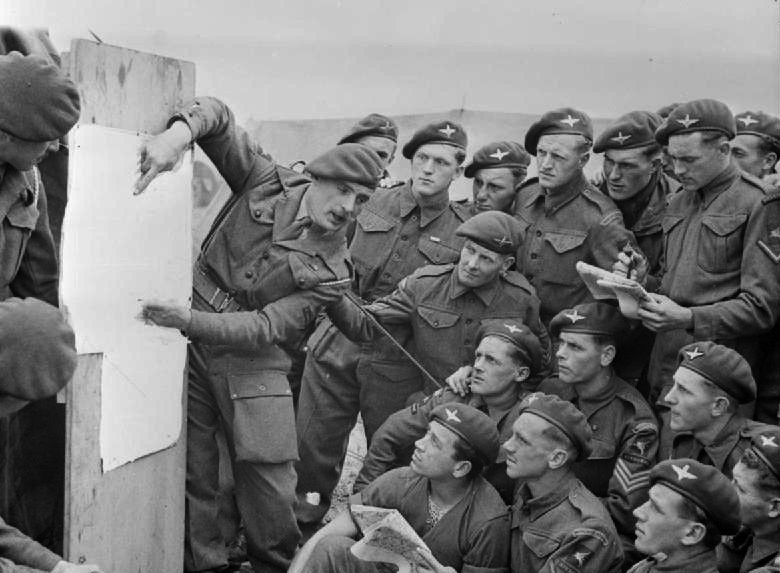
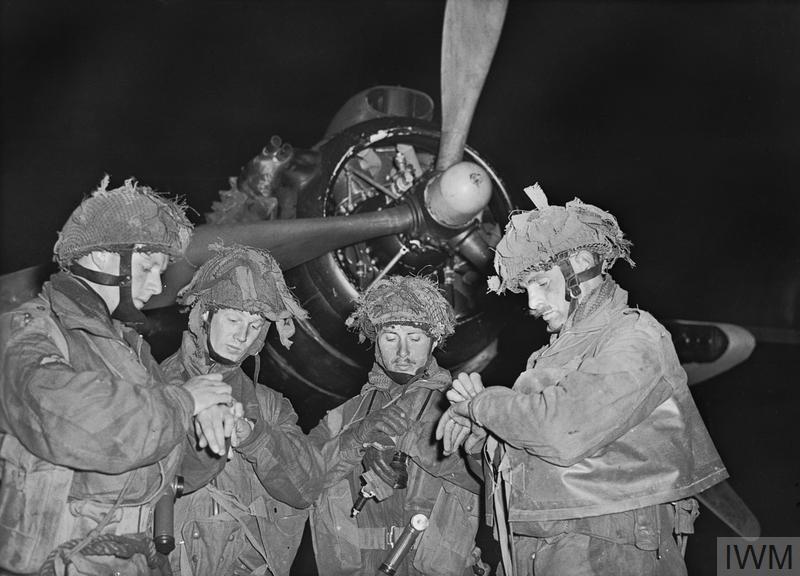
The Pathfinders task:
Drop and Landing zones for the British 6th Airborne were due to be marked by troops from the 22nd Independent Parachute Company flying from the Oxford airfields of Harwell and Brize Norton. Their aircraft were the rather cramped twin-engine Armstrong Whitworth Albemarles generally considered to be obsolete by 1944. The Albemarles were less of a choice, more of a necessity given the demand for more suitable craft for parachute operations at D-Day. Nonetheless, given the critical task of the Pathfinders, it might have been better for them to have been issued with top quality transport.
The first 295 Squadron Albemarle, piloted by Squadron Leader Merrick took-off from Harwell at 23:10 on June 5th followed by a second aircraft piloted by Flight Sgt. Kirkham of 570 Squadron. Two further 38 Group Albemarles followed from Harwell along with two more from Brize Norton.Each aircraft carried a stick of 10 parachutists and two aircraft were allocated to each of the three drop zones ‘K’, ‘N’ and ‘V’. Difficulties were experienced at all three locations with Drop Zone ‘V’, dedicated to the destruction of the gun battery at Merville, particularly compromised.
The two aircraft bound for 233 Squadron’s target drop zone ‘K’ approached the target for the 22 Company parachutists at an altitude of 500′ at between 00:17 and 00:20. The weather was poor and the aircraft very cramped for the team of ten and their bulky equipment. Multiple passes over the target were required with some of the sticks of paratroops recorded as being unable to drop as quickly as intended. Nonetheless, by 00:35, Lt Bob Midwood’s group had been able to set-up the Eureka beacon which would transmit codes C and D to 233 Squadron’s Rebecca receivers. The high intensity tripod-mounted Holophane lamps for DZ ‘K’ were also set-up and, despite an injury sustained during the drop, Lt Midwood was able to provide protection for the units. Lt. Vischer had less luck; his stick dropped at 00:20 but close to the south-east corner of DZ ‘N’ rather than his allocated target of DZ ‘K’. By 00:35, this stick had linked-up with troops from Capt. Tait’s team and the Eureka unit broadcasting the channels dedicated to DZ ‘K’ set-up. While understandable that Vischer’s men wouldn’t necessarily know that they had been dropped in the wrong location had they been on their own, it is strange that they installed the ‘K’ DZ alongside Holophane lamps marking the ‘N’ DZ and in the company of troops dispatched from a different airfield to mark a different landing zone. The problems were compounded by damage sustained to several Eureka units during the drop and by some Holophane lamps being hard to see having been set-up in standing crops. The 6th Airborne Division troops in the 46 Group Dakotas were following 30 minutes behind the Pathfinders and, with the ground marking compromised, it is a tribute to them that they managed to accomplish most of their objectives by midnight on 6th June.
References: www.6juin1944.com , www.89fss.com
The 233 Squadron aircraft towing gliders made the first pass across Drop Zone ‘K’ and, between 00:50 and 00:53 on June 6th, the gliders were released. Subsequently, 406 paratroops were dropped from the remaining 24 aircraft between 00:54 and 00:58 to the north-west of Toufreville. The confusion on the ground caused by the mis-location of pathfinder Eureka beacons was unknown to the aircrew, by now returning to base. The operational assessment from the Squadron Records was therefore that, apart from the loss of two aircraft, the mission had gone well. Subsequent historians have been excessively critical of Transport Command’s navigation to the drop zones. Max Hastings’ ‘Overlord’ book is particularly disrespectful to aircrew who risked and, in some cases, lost their lives (10). The truth probably lies somewhere between the two.
KG356, piloted by Flying Officer Jones, RCAF, was one of the two 233 Squadron casualties. Although hit by enemy fire, Harvey Jones continued to the drop area and, once the complement of paratroops had exited the aircraft, attempted to maintain height while his crew baled-out. Too low to escape himself, FO Jones, with Wireless Operator Warrant Officer Engleberg still on board, attempted a controlled landing near Bassenville. While Engleberg survived, FO Jones was killed (11).
KG429, piloted by Warrant Officer Murdo Murdoch McCannell, was destroyed after being hit by anti-aircraft fire from the naval dockyards. The Dakota crashed to the north east of Colombelles with the loss of all crew and at least 18 of the 19 paratroopers on board. The dead were buried in a communal grave near the local Church of St.Martin and later moved to Ranneville War Cemetery. There was reportedly one survivor, Company Sgt Major Leslie Jones (12).
(10) Hastings groups USAAF and RAF crews together in his comment in ‘Overlord’: ‘The drops were marred by the poor performance of many of the Allied Dakota pilots who, by a combination of unsteady navigation and extravagant reaction to German flak, released their parachutists with near-criminal carelessness’. This doesn’t consider the errors experienced in drop zone marking nor the banks of cloud experienced at critical locations. While the flak may have been ‘severe’, two of the 233 Squadron aircraft were lost. As the thread on ‘D-Day Doll’ shows, the USAAF also had issues with weather over the drop zones but many Troop Carrier Squadrons managed well. ‘Overlord – D-Day and the Battle for Normandy’, Max Hastings, 1984, Touchstone.
(11) Details of F.O Harvey Edgar Jones are to be found at https://www.veterans.gc.ca/eng/remembrance/memorials/canadian-virtual-war-memorial/detail/2343054
(12) Leslie Jones, CSM of B Company, 8th Battalion, 3rd Parachute Brigade went on to be captured at Giberville in July 1944 but, following escape, joined the French Resistance and remained with them until repatriated on 13th September 1944. The crash of KG429 is discussed in thread: http://ww2talk.com/index.php?threads/pte-gerald-clarke-aicraft-shot-down-on-d-day.60146/ which also gives the roll call of those who died.
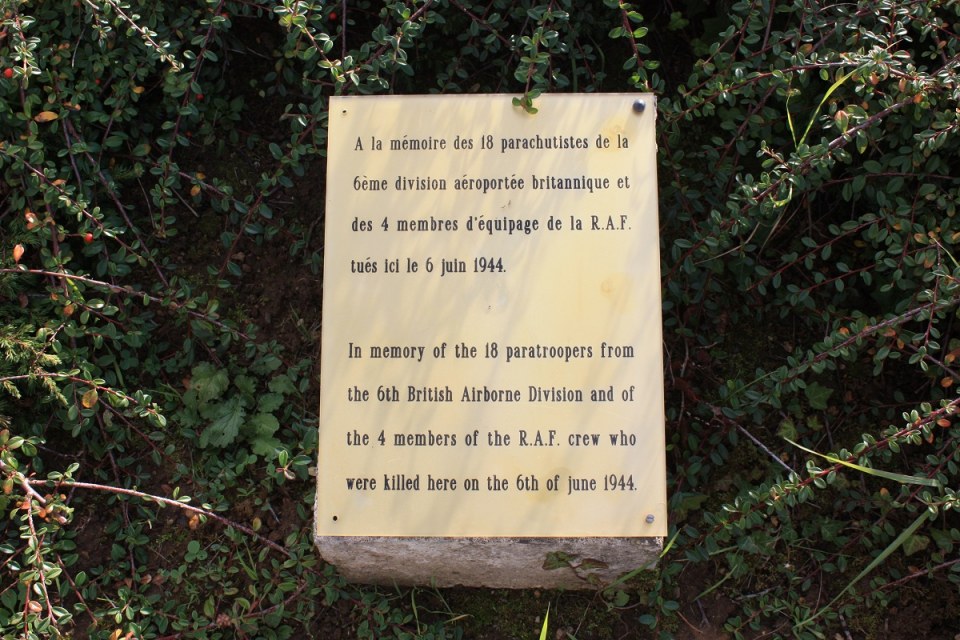
On D-Day -1, FZ681 took off from Blakehill at 23:15, crewed by F/Sgt Coventon (Captain), F/Sgt Beighton (Co-Pilot), F/Sgt Edwards (Navigator) and F/Sgt Mirfin (Wireless Operator). She was one of 24 Dakotas carrying 3rd Parachute Brigade troops to Drop Zone ‘K’ at Touffreville as part of Operation Tonga. Having completed the drop successfully, FZ681 was back on the ground at Blakehill Farm by 02:49 on June 6th. She was refuelled and prepared for the following re-supply mission, RobRoy, due to take place that night. The same crew was assigned to FZ681 and take-off was at 22:23 as a part of 21 aircraft scheduled to drop 371 panniers containing food, ammunition, fuel and explosives to the 6th Airborne who were fighting to the east of the River Orne at Amfreville. The drop took place between 23:50 and 00:01 on June 7th and 18 Dakotas landed back at Blakehill Farm between 01:25 and 02:00. Two aircraft, KG329 and KG424, were lost during the mission and KG441 had returned to base with electrical problems after two attempts to reach the drop zone. KG453, FZ688 and FZ672 had all suffered damage from ground fire which had been particularly sustained around Cherbourg and Ouistreham (13).
The two leading aircraft of 233 Squadron’s Rob Roy formation were KG424 flown by Squadron Leader Wright and KG329 flown by Flying Officer Wood. Both were seen to take anti-aircraft hits while crossing the coast -possibly ‘friendly fire’ from allied shipping. KG424 was seen to break formation to starboard in a controlled dive with smoke issuing from the engines, while KG329 burst into flames. Two of KG424’s crew, F.O.Semple RCAF and F.O.Williams RAF, subsequently spent 22 days in Normandy, eventually returning in style to Blakehill Farm on 3rd July in a 271 Squadron Dakota.
For the week following D-Day, 233 Squadron was on stand-by with operations confined to air tests and local formation flying. Meanwhile, in Normandy, the Royal Engineers were working hard to establish advanced landing grounds (ALGs). The first, B1, was at Asnelles-sur-Mer immediately adjacent to Gold Beach and was little more than an emergency landing strip. A more comprehensive ‘portable’ airfield was completed on 10th/ 11th June at B2, Bazenville; it would have been on-line a day earlier but for the unscheduled arrival of a B-24 Liberator which ripped-up some of the pierced-steel-planking just before completion. B2 was a few kilometres inland and offered 233 Squadron aircraft the opportunity to land close to the front line with supplies and armaments before returning to England with casualties. On 13th June, KG427 and FZ686 travelled to B2 under fighter escort with 4 tons of screw pickets for further airstrip construction work. They became the first Transport Command aircraft to land in Continental Europe and also the first British aircraft to evacuate wounded. This didn’t go un-noticed and, upon return, they were met by the Free World’s Press. Part of the operation’s newsworthiness was that the nursing orderlies flying with the Dakotas were WAAFs who became the first women to be sent into a war zone by the British government (14). Heavy anti-aircraft fire was spotted 5-6 miles south of the B2 ALG but no other enemy action was encountered. On the same day (15), two further 233 Squadron aircraft, KG440 and FZ678, carried Wing HQ personnel from Thorney Island to B2 with a 5-Spitfire fighter escort.
(13) The 21 aircraft outbound on the Rob Roy operation included KG424, KG341, KG329, KG441, FZ666, FZ692, KG455, KG448, KG412, FZ681, KG566, KG437, FZ688, FZ669, FZ672, FZ680 and KG315.
(14) The following section on the airborne nurses (below) notes that nurses had actually landed a couple of days earlier with D-Day forces.
(15) The Operations Record Book Summary of Events says June 14th.
The Flying Nightingales Auxiliaries:
Potential nursing auxiliaries, often with a medical background, were given a 6-week training course at Hendon which was designed to prepare them for the kinds of injuries they would encounter on air ambulance flights. Bullet wounds, head injuries and missing limbs were considered and training given in the administration of morphine and oxygen and transfusion of blood. As nursing auxiliaries graduated, they were moved to the three designated air ambulance air bases (Blakehill Farm, Down Ampney and Broadwell) where airborne training was given. The WAAFs gained flying experience on day and night exercises in 46 Group Dakotas and no auxiliary could be expected to pass if air sickness was experienced. Dingy training was given at a swimming pool in Bath and, during downtime, the auxiliaries even helped with construction projects at Blakehill and Broadwell.
Post D-Day, airborne casualty evacuation had to await the construction of advanced landing grounds to accommodate the Dakotas. By June 10th, the first strips suitable for transport aircraft were ready and, on June 12th, the WAAF medical orderlies were summoned to Hendon for a briefing by the Director General of RAF Medical Services. Three WAAFs were selected to take part in the next day’s operations and told they should be prepared to report for duty at an ungodly hour the following morning. Corporal Lydia Alford of Eastleigh, Leading Aircraftswoman Myra Roberts of Oswestry and Leading Aircraftswoman Edna Birbeck of Wellingborough had all been trained medically before joining the RAF but none had ever set foot outside Great Britain. They checked-in at RAF Blakehill Farm before dawn on June 13th and enjoyed an aircrew breakfast – not a courtesy that was always extended to WAAF auxiliaries in the future. The three WAAFs then attended the regular crew briefing followed by the issue of life jackets and parachutes. Unusually, senior RAF officers were present to wish bon voyage to the three ladies as they boarded their respective aircraft. 271 Squadron had a flight of Dakotas seconded to 233 Squadron at Blakehill Farm, ‘A’ flight, and one of their aircraft was in company with two provided by 233 Squadron. KG562 was first off the ground at 05:04 heading for ALG B2 at Bazenville. On board were nursing auxiliary Lydia Alford along with four press reporters and an RAF Officer*. The other two aircraft, FZ686 and KG427, were airborne two minutes later. The three Dakotas carried the first British service women to be officially sent into a war zone by air**.
* The RAF officer was possibly Flt Lt Stan Devon, the photographer who captured many of the images of casualty evacuation featured here.
** While these three WAAfs landed at Bazenville on D+7, they were actually preceded by two WAAFs who landed at Juno Beach from a landing craft on D+5. Nurses Iris Bower and Mollie Giles were attached to a Mobile Field Hospital and, following their arrival in France, they followed the operations through France into Germany.
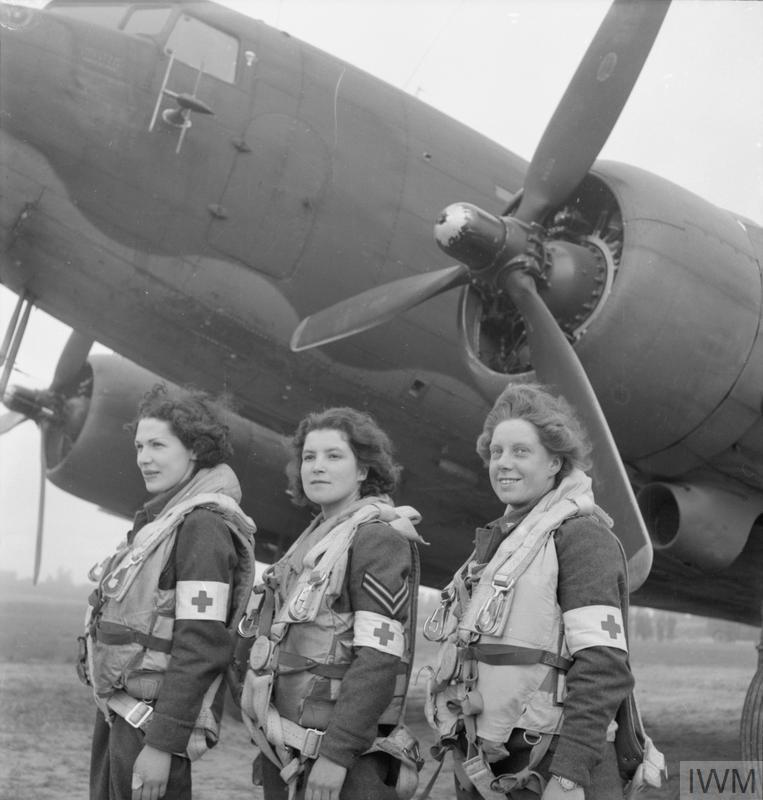
Lydia Alford had been born at Horton Heath, near Eastleigh, on 4th July 1916 and originally trained as a nurse at Southampton’s South Hants Hospital before joining the WAAF as a nursing orderly. Speaking, some years later, to the Sunday Chronicle newspaper, she described her first mission to France:
” Chiefly, I remember the dust which was everywhere, coming up in great clouds. While the supplies were being unloaded I tried to make the wounded men as comfortable as possible in all that dust. I had water to give them and panniers of tea. There was a little stray dog which came up from somewhere or other and started to play with the wounded – it cheered them up no end”
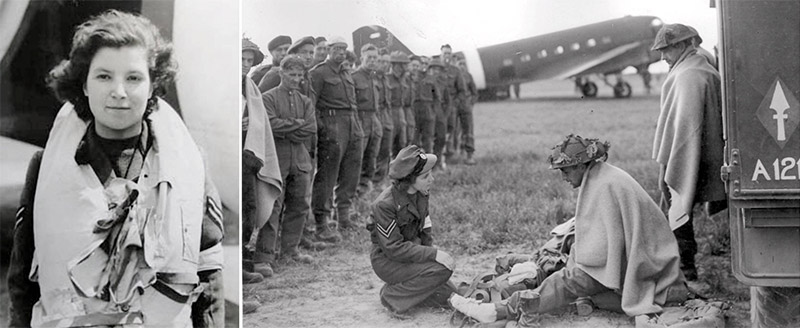
Lydia was on the first Transport Command aircraft to land on the Continent and, following offloading of freight and boarding of casualties, her Dakota was the first to return to Blakehill. The weather conditions had deteriorated during the day and a milky sea mist was rolling in off the English Channel. Wounded personnel who had some mobility were assembled and loaded onto KG562 and the aircraft departed leaving the remaining two 233 Squadron aircraft and their nursing auxiliaries, Myra and Edna, on the ground. While waiting for the mist to clear, the auxiliaries tended to the wounded and were briefly able to tour around the landing ground in a jeep. The troops were amazed to see the WAAFs so close to the battlefield and, no less enthusiastic, a farmer’s daughter ran up to the jeep to present the ladies with a bunch of flowers. Meanwhile, in the air, Lydia was serving tea and tending to the bandages of the wounded on board her Dakota. She talked to those with shell shock and used her parachute to support the leg of a wounded Canadian soldier. KG562 was back on the ground at Blakehill at 13:55 and was immediately subjected to a barrage of journalists and photographers wanting to record the first evacuation flight and the first mission with a WAAF nursing orderly. Later in the afternoon, the visibility improved and KG427 and FZ686 were able to depart B2, arriving back home at 19:22 and 19:05 respectively. Some sources quote this June 13th mission as a trial run for a casualty evacuation programme which commenced on June 18th. However, 233 Squadron was again flying casualties on 14th June^^. Wounded personnel returning to the three Cotswold airfields were assessed by RAF medics and assigned to relevant hospitals: burn victims to Odstock in Salisbury, head injuries to St.Dunstans, spinal and skin graft cases to Stoke Mandeville.
The WAAF auxiliaries didn’t enjoy the best of facilities on these flights. They had no assigned seats on the Dakotas and usually sat on the freight on the way out while standing-up attending to their patients on the return journey. The Dakotas could be equipped with nine stretchers on each side in three vertical stacks of three. There was usually a combination of stretchers and walking wounded.
^^ The 233 Squadron Operations Record Book says that 2 Dakotas flew to Bazenville, B2, again on June 14th. The Detail of Work Carried-out Record book gives FZ678 and KG440 lifting at 13:00 on June 13th and returning at 21:50. Given that the weather was poor on the afternoon of 13th, possibly 14th was more likely.
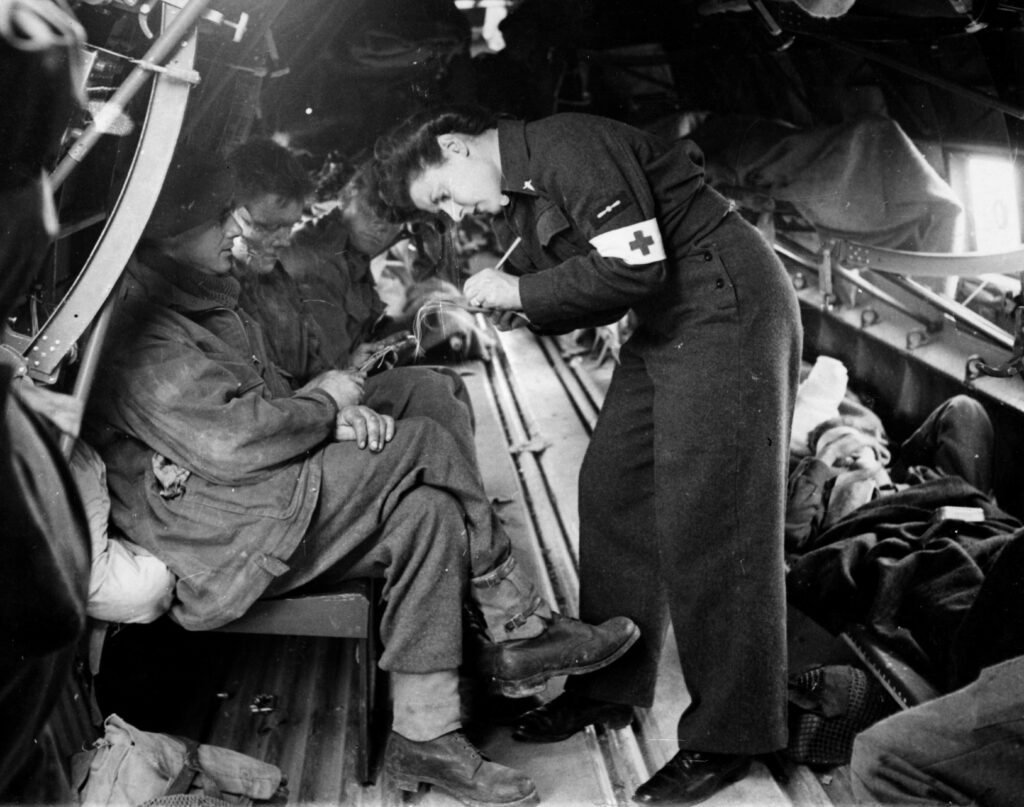
233 Squadron Dakotas were often emblazoned with small red-cross mission badges representing each evacuation flight, but they were not allowed to be marked as ambulance aircraft as they carried munitions, stores and troops on the outbound sector. They, consequently, had no immunity from Luftwaffe attack and during the Normandy campaign and, later, Market Garden, the flights were to advanced landing grounds close to front line fighting. One WAAF nursing auxiliary, Hebridean LACW Margaret Campbell, was lost when Dakota FZ655 of 437 Sqdn RCAF was destroyed near Dunkirk in October 1944. Many of the auxiliaries suffered less tangible damage in the form of stress from caring for patients with appalling wounds.
Lydia Alford continued as a WAAF nursing orderly throughout the Normandy Campaign and also served during the Market Garden operation in September of that year. Following the war, she returned to work as a nurse at the South Hants Hospital but, unfortunately, suffered from ill health during her later life and died in 1993. She is buried at Pembers Churchyard, Fair Oak, close to her birth place.
Leading Aircraftwoman Edna Birbeck continued in the service until autumn 1945. She met her future husband, Glyn Morris, while flying with 233 Squadron and married him in March 1945. Glyn Morris was a Wireless Operator, almost certainly Flt.Sgt D.G.Morris who flew with Squadron Leader Miller’s crew. They generally flew KG313 but, when Second Pilot Flt.Lt.Frank Priestley graduated to Captain he took Flt. Sgt. Morris with him and their regular Dakota became FZ681. Many years after the war, RAFA Headcorn and Skyways Coach Air gathered together around 30 members of 233 Squadron in August 1978 to celebrate the war service of FZ681/ G-AGYZ. Edna Morris attended and confirmed that she, as well as her husband, had regularly flown in FZ681 when the return sectors were due to carry wounded soldiers. She reminisced that the casualties “always wanted tea, those that could drink. We’d carry an industrial-sized urn. And they’d always want to know when we were over the coast (of England). I’d tell them that and say ‘it won’t be long until you’re home’ and they’d cheer”. Remaining with 233 Squadron for the remainder of her flying career, LAW Edna flew on 60 casualty evacuation flights and none of her charges died while in her care. She was also reported to be one of the first aircraft to land in Copenhagen after liberation but, whether this was on Barry Stableford’s crew, Lew Cody’s or a third aircraft is unknown. Edna Morris and the third of those ‘First Nightingales’, Myra Jones (nee Roberts), also met-up in June 1994 at the Imperial War Museum, 50 years after D-Day for a symposium on the Flying Nightingales. Glyn Morris died in 1987 and Mrs Morris died on October 24th 2004, aged 80, shortly before the surviving seven Nightingales were presented with Lifetime Achievement awards by the Duchess of Cornwall. She was survived by her three daughters.
Acknowledgements: Information regarding Lydia Alford is largely taken from an article by Jake Simpkin published in Volume 46, #3, of the Hampshire County Magazine, January 2006. The article draws on original information provided by Lydia’s niece, Heather West, and also appears at www.jakesimpkin.org . Further information was obtained from ‘The WAAF at War’ by John Frayn Turner, the RAF Museum website and www.memorialflightclub.com. Edna Morris lived in Gloucester but was from Wellingborough, Northants, and further information is from the Sywell Aviation Museum Facebook page.
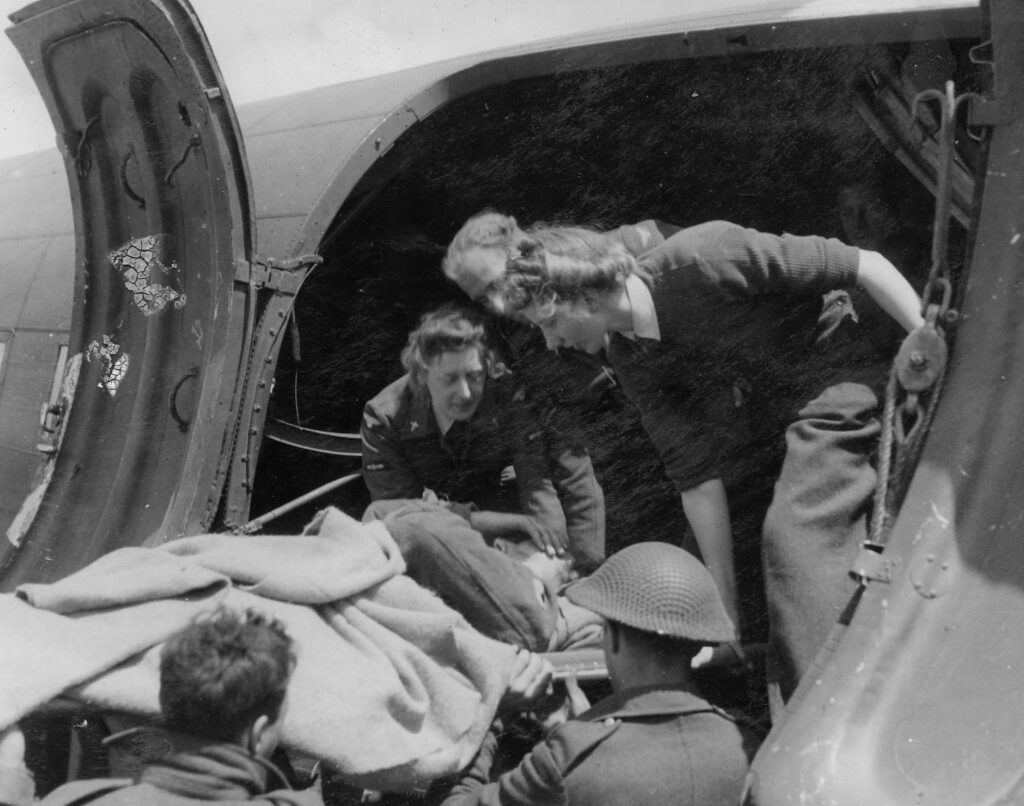
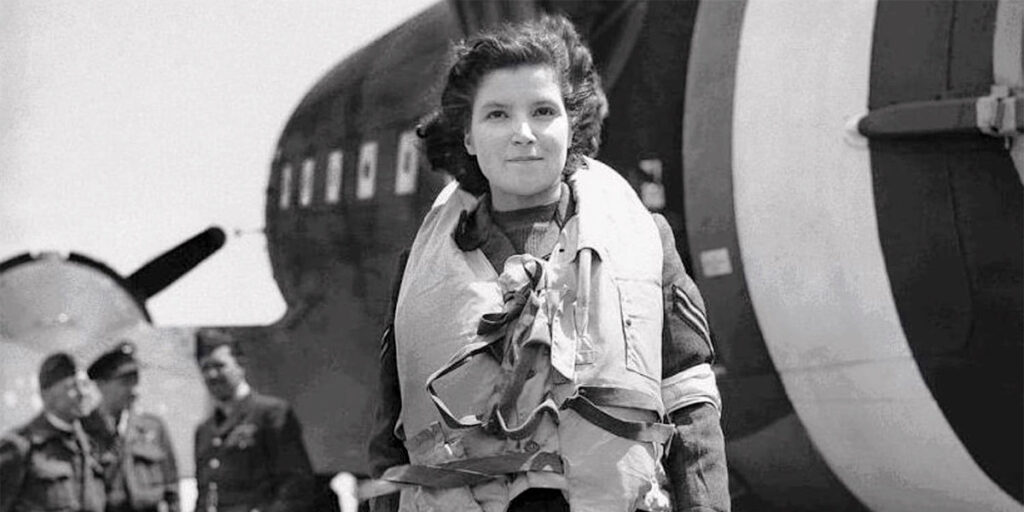
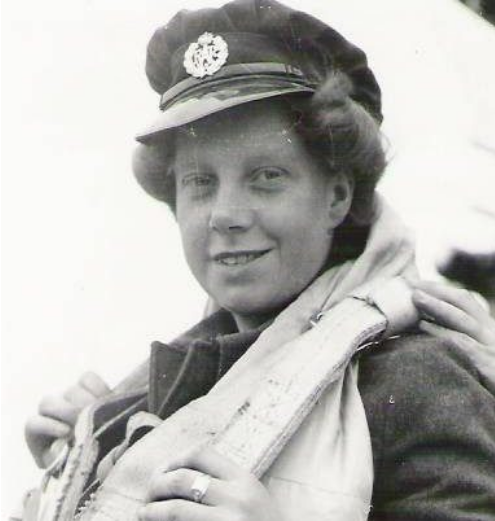
Post D-Day Operations:
St Croix-sur-Mer, ALG B3, opened on June 10th, claimed the title as the first real Advanced Landing Ground when it opened on June 10th. 233 Squadron visited B3 in force on June 15th when seven aircraft, led by Wing Commander Morrison transported personnel and equipment of 144 Wing HQ from Ford in Hampshire. 114 casualties (75 on stretchers) were evacuated. The aircraft involved were KG559, KG437, KG341, KG340, FZ665, FZ678 and FZ686. One further aircraft, KG351, transported VIPs from Northolt to B2 and back again on June 15th. FZ681 was in action for the first time since D-Day on June 16th when she lifted at 14:05 from Blakehill in company with KG437 en route to B5 Le Fresne-Camilly with 4.5 tonnes of screw pickets and ammunition. the pickets were necessary to hold-down the square mesh trackway used for temporary runways such as Fresne-Camilly. B5 had been constructed by 88 Airfield Construction Company, Royal Engineers, between June 9th and June 13th. The front line was only a mile or so to the south and the strip was under continual fire from Wehrmacht troops. They were directed by artillery spotters installed on the towers of the Scheider steel works in the Colombelles suburb of Caen to the south-west. Indeed, a Dakota had been destroyed by enemy fire the previous day, June 15th (16) and, within five minutes of the arrival of FZ681 and KG437, German shelling had commenced. the two Dakotas took-off safely and hopped to B2 where they embarked 24 stretcher cases and five walking wounded for the flight back to Blighty.
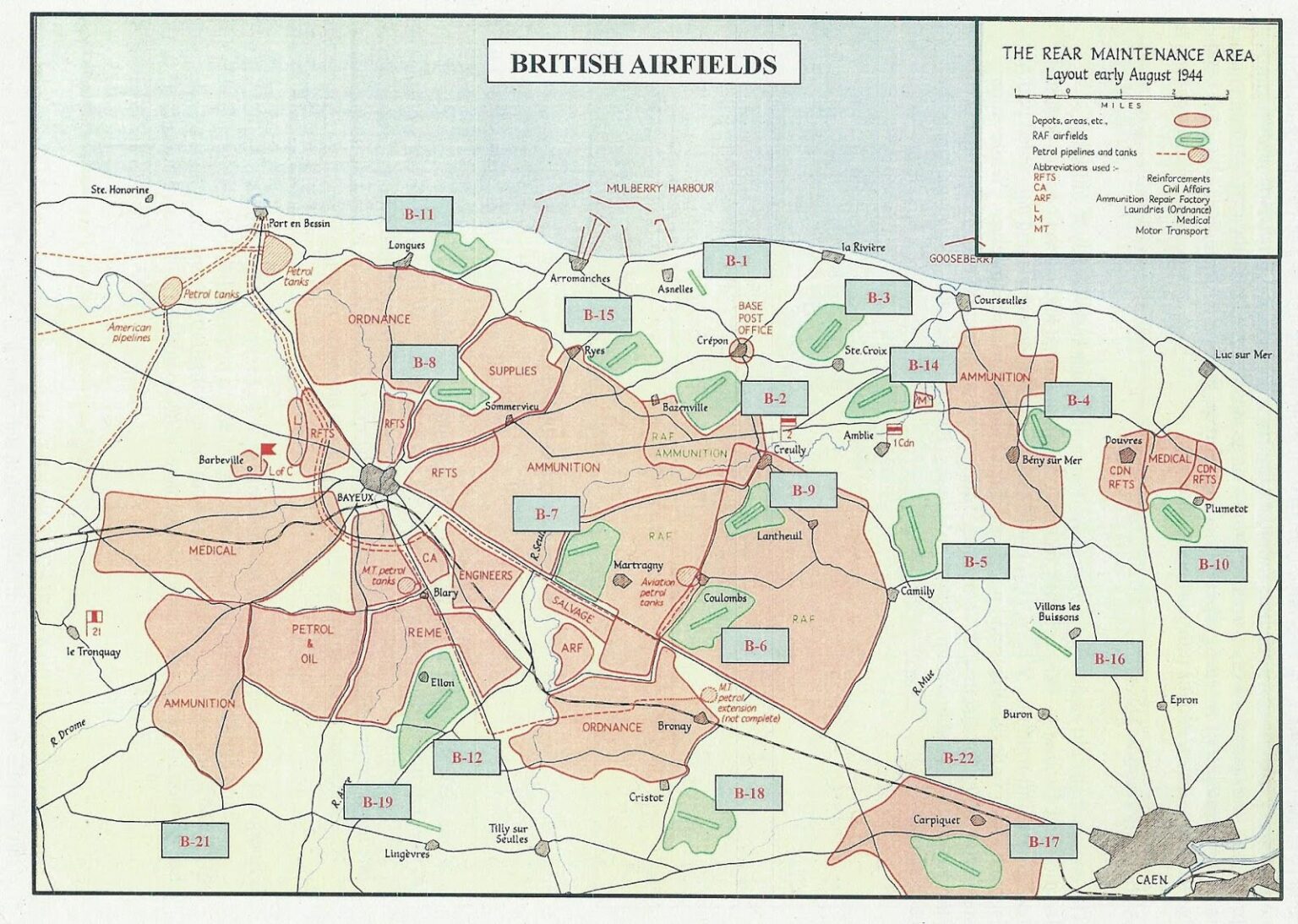
June 16th also saw Wing Commander Morrison in KG561 leading six aircraft from Tangmere to B2 with 104 personnel of a fighter wing. They returned with 111 wounded personnel, 82 on stretchers. FZ665 carried glider personnel and a jeep to B4, Beny-sur-Mer, which had been opened for traffic just the previous day.
June 17th saw many of the squadron aircraft carrying-out glider towing and formation flying local to base while, the following evening, five Dakotas flew to B2 to deliver ammunition and recover 90 casualties. Two further aircraft departed at the same time, en route to B4, carrying 20 500lb bombs.
On June 19th KG539 was flown from Blakehill Farm to Odiham by Wing Commander Morrison where VIPs were boarded for the flight to B3, St.Croix. The second pilot was 46 Group’s AOC, Air Commodore Fiddament, no stranger to France as he had been an RFC fighter pilot there in WW1.
June 20th and 21st were busy days for 233 Squadron. On 20th, 10 aircraft departed for B9, 9 for B3 and 3 for B4. Outward cargoes consisted largely of 500lb bombs while full complements of stretchers and walking wounded were accommodated on the return. FZ681, commanded by Flying Officer Gustafson, was airborne from Blakehill at 14:03 carrying 500lb bombs and boxes of detonators en route to B3. the Second Pilot was F/O Tozer, Navigator F/O Allan and Wireless Operator Flight Sergeant Hickey. Their group of five Dakotas evacuated 47 stretcher cases, 20 walking wounded and two passengers. The following day saw a similar pattern, with 16 aircraft lifting from base just before 18:00 and returning either side of midnight. Three Dakotas delivered bombs to B2 while FZ681 was part of 13 aircraft delivering 500lb bombs to B4. This time, she was flown by F/Sgt Russell assisted by Second Pilot F/S Jones, Navigator F/S Schofield and Wireless Operator W/O Burgess. the 13 aircraft returned with 19 stretcher cases and 21 walking wounded.
The remainder of June followed much the same pattern with supply flights to Advanced Landing Grounds returning with evacuated casualties. ALGs visited included: B2/ Bazenville, B8/ Sommervieu and B11/ Longues-sur-Mer. One aircraft, FZ669, had to return to base with engine trouble on June 25th but, otherwise, operations ran smoothly. Two aircraft flew to Leicester East on June 24th to collect extra aircrew who had been training in day and night cross-country flights and container dropping at 107 Operational Training Unit. Also on June 24th, FZ681 carried-out a typical 2-aircraft mission to B2 in the company of KG315. Lifting from Blakehill at 09:40, captained by F/S Coventon, FZ681 was carrying a ton of fighter spares plus 8 army officers while KG315 flew empty on the outward leg. FZ681 returned with 16 stretcher cases while KG315 transported twenty-one 83 Group aircrew personnel and one army Brigadier.
On June 27th 1944, two 233 Squadron aircraft took a large shipment of newspapers and periodicals to B2. This was the precursor to a regular mail run which commenced in the first week of July (17). The squadron’s re-supply and casualty evacuation missions were described on BBC Radio on June 28th, at the end of a highly eventful month of operations.
(16) See https://rafoverlord.blogspot.com/2019/05/the-b5-airfield-at-le-fresne-camilly.html
(17) 233 Squadron were the first Transport Command squadron to carry private mail and newspapers to the Normandy troops.
The newly-joined aircrew took part in glider-towing and formation flying on the last day of June and the first week of July. Sergeant Ken (actually Knivett) Cranefield, who would be awarded the DFC at Arnhem, and his crew were among those who arrived from 107 OTU and began training and operations with 233 Squadron. While the airmen would remain together as a crew, they were not assigned to specific aircraft and would fly many different Dakotas. The make-up of the crew illustrates how many were non-commissioned officers. Ken Cranefield had joined the RAF in February 1941 and completed pilot training in the USA. After early experience with Vickers Wellingtons, he graduated to Dakota flying in Spring 1944 as a sergeant. His Second Pilot, Barry Stableford, RNZAF, is recorded as being a Flight Sergeant while Terry Holmes, the Navigator, and D.Hastings, the Wireless Operator were both sergeants.
Meanwhile, personnel changes at the top saw the Squadron CO, Wing Commander Morrison, promoted to Group Captain and transferred to Broadwell. Presumably, this curtailed the series of flights he had made to France transporting military VIPs to frontline airstrips at the end of June. Squadron Leader Miller took over briefly as Officer Commanding from July 11th until the arrival of Wing Commander W.E.Coles on July 18th (18).
There was a lot of general transport work as the allied forces advanced in Normandy. Ground attack squadrons to support the army were on the move and 233 assisted with the transport of 263 Squadron from Bolt Head to Hurn and, subsequently, pilots and freight from Hurn to B3/ St.Croix. The Advanced Landing Ground B8 at Sommervieu to the east of Bayeux was a frequent destination for 233 Dakotas carrying armaments, the mail, personnel and jeeps outbound, wounded troops on the return. Each day, a couple of Dakotas would also take mail and newspapers to Normandy, usually to B14 at Amblie which was designated as a Rearming/ Refuelling strip. The newsprint was generally collected from Thorney Island before the Channel crossing and the return journey often carried blood plasma containers as well as letters and casualties. FZ681, piloted by F/S Coventon’s crew, operated this service on July 13th and, on the following day, she was flown to Predannack in Cornwall by Ken Cranefield’s crew. Twenty-five personnel were transferred to Bolt Head airfield in South Devon. FZ681 remained there until 17th, when she was flown back to Blakehill Farm. The crew then spent the best part of the next week training in glider towing and formation flying in KG412, KG415 and KG448 before returning to FZ681 for operational flying on 25th July. FZ681 took off at 07:59 on July 25th for the short 1 hour 15′ hop from Blakehill to Eastchurch as part of a 3-aircraft mission to transport elements of the Typhoon-operating 183 Squadron to the ALG B7 at Martragny. FZ681 carried 4000 lbs of freight and one passenger on the outbound sector and returned via B14 with 22 wounded.
(18) Wing Commander W.E.Coles had already enjoyed a distinguished career since becoming a Pilot Officer in 1938. For bravery at Tobruk, with 261 Squadron on 29/11/1941, he was awarded a DFC. He subsequently served with Transport Command in the Near East flying Dakotas with 117 Squadron during Operation Thursday, the allied invasion of Burma. The US Military awarded him the DFC for his work in this theatre during May 1944.
On August 1st 1944 Ken Cranefield, by now a Warrant Officer, and his crew flew FZ681 from Blakehill Farm to Westhampnett. They remained on the ground overnight at this Sussex airfield, now the Goodwood Racing Circuit, before embarking passengers the following day for the fifty minute flight to Manston in Kent. This 5-aircraft sortie in the company of four other Dakotas was typical of 233’s Inland Transport operations. The flight from Manston to Blakehill took just over an hour but some of the Squadron’s operations were more far-reaching. On August 3rd, two Dakotas are recorded as transferring 7200 lbs of freight and six passengers between the Galloway airfields of Dumfries and West Freugh, a long way from the Cotswolds. On the same day, six 233 Squadron Dakotas transferred 66 2nd Tactical Air Force (RAF) personnel from Northolt to B8/ Sommervieu, returning with 82 stretcher cases and 15 walking wounded. KG447 was tasked with transporting an interesting cargo back to Blakehill farm: a captured German midget tank.
On August 4th 1944, Ken Cranefield’s crew flew FZ669 on the morning newspaper run via the paper depot at Thorney Island to B14/ Amblie before returning with 18 stretcher cases and six walking wounded. This was a typical schedule which would run day-in, day-out even as the rest of the Squadron might be on other duties or exercises. Poor weather precluded flying for much of August 5th but, on the following day, Warrant Officer Cranefield’s crew were aloft in KG415 with 13 other 233 Squadron Dakotas on a 1-hour 40 minute glider-towing exercise labelled Consternation II. The gliders were released over Netheravon. The Cranefield crew then switched back to FZ669 for a two and a half hour night cross-country flying exercise. Meanwhile, FZ681 had been flown by Flying Officer Gustafson’s crew to eastchurch and on to B3/ St.Croix with 15 passengers. After the short hop to the medical gathering point at B14, FZ681 returned to base, arriving at 20:57 with 6 stretcher cases and 17 walking wounded. FZ681 was then back with W/O Cranefield’s crew on the night of 8th/ 9th August for further exercises in mass glider night cross-country operations as a part of Operation Hole. While the exercise took up 12 of 233’s aircraft, regular cross-channel operations to France involved three Dakotas, while another 12 aircraft were occupied on internal flights within the UK on August 8th. Much of the exercise work was geared towards imminent operations on the Continent which were subsequently cancelled as the Allies made rapid advances. Despite the night-towing practice, future 233 glider operations would take place in daylight hours.
The Dakotas were employed on pannier-dropping exercises on August 9th and further glider towing practice on 11th. The Squadron also used several Avro Ansons on passenger taxi duties around Britain and across to France (19). The Squadron’s Commanding Officer, Wing Commander Coles, took the controls of KG427 on August 11th in order to fly to B14 to collect General ‘Boy’ Browning’s personal kit and Batman. The Wing Commander flew them back to Northolt along with 20 walking wounded who carried-on to Blakehill Farm for medical assessment. One slightly more exotic mission was carried-out by KG351 and KG399 when they departed from RAF Lyneham on August 9th en route to Rabat, Morocco with a special cargo destined for Rome. Squadron Leader Mackenzie and Flying Officer Hyne flew their respective Dakotas on two Maison Blanche the following morning and then across the Mediterranean to land at Littorio, Rome at 19:25. With the cargo safely delivered, they retraced their route on 11th August, via Naples and Gibraltar, to arrive back at Lyneham having been flying for 33 hours of their 72-hour ‘holiday’.
On 19th August 14 aircraft carried-out a large scale transfer of 145 Wing personnel from Tangmere to B8/ Sommervieu before transiting to B14 to collect 314 wounded personnel. W/O Cranefield’s crew flew KG566 and FZ681 was piloted by F/O M.Aden.
(19) Ansons used by the Squadron included Nk446, NK487, NK663, NK666 and NK668.
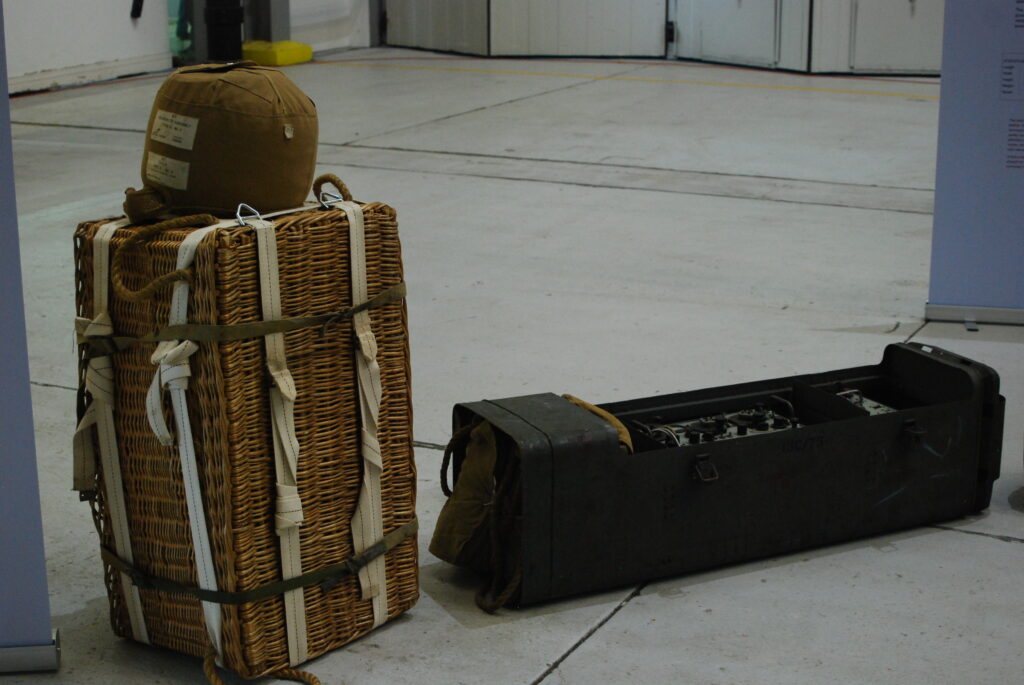
The weather which had been so borderline during Overlord in June 1944 had steadily improved during July but, by August, it was decidedly mixed again. On 21st August a complement of ten Dakotas was dispatched at short notice to Chambois in France for a pannier drop of anti-tank ammunition for the allied forces attempting to trap retreating Wehrmacht troops in the ‘Falaise Pocket’. The weather was poor with heavy rain and a low cloud base only a few hundred feet above the fields of Normandy. 233 Squadron was flying in parallel with other 46 Group aircraft from Down Ampney and all experienced difficulties. Only four of the 233 Squadron Dakotas were able to find the drop zone but, fortunately, by the following day, the ‘Falaise Gap’ had been plugged and the Allies were on their way to Paris.
General Patton’s troops entered the French capital on August 25th and the re-supply/ evacuation destinations for 233 Squadron expanded eastwards accordingly. A six-aircraft operation on August 26th went in the opposite direction, with personnel and equipment transferred from Heston to the American Advanced Landing Ground A30 at Courtils, near Avranches. FZ681 was flown on this mission by Squadron Leader Mackenzie who was also in command for the following day’s operation to Orleans-Bricy. This airfield had only just been liberated and the landing surfaces were rough and uneven. It had, nonetheless, been selected as the delivery point for food supplies being shipped to the newly-free Paris. Over the next six days it became the focus for a mini-airlift carrying sugar, margarine, milk, beans, fish, pork, soya, chocolate, bacon and biscuits. Up to six hundred visits were made in total by participating aircraft and air traffic control became an issue with aircraft sometimes having to circle for 60 to 90 minutes in the stack. FZ681 fell victim to the uneven landing surface and suffered a hydraulic problem with the tail wheel. The crew returned to Blakehill Farm as passengers and the aircraft had to be collected the following evening. The Paris airlift accounted for 66 sorties by the Squadron with a total of 231 tons of food delivered.

All further commitments were cancelled on August 31st as the Squadron was placed on readiness for an airborne operation. Fifteen aircraft each collected a glider from Netheravon and returned to Blakehill ready for action. A series of airborne operations had already been proposed during late August for destinations in north-east France and Belgium but many had been deemed unnecessary given the rapid advances being made by conventional forces. Lille and Liege had both been projected but the operations had been cancelled. Eventually, Operation Linnet was suggested with target areas around Tournai, Lille and Courtrai and it is probably this mission which prompted 233’s August 31st standby. The operation evolved into Linnet II before being cancelled on September 4th owing partly to poor weather and partly to allied successes. The airborne forces, however, remained ready to be deployed and the Allies needed to both capitalise on the German retreat and secure North Sea ports for future logistics. A new operation, Comet, was planned and Transport Command squadrons were, once again, placed on standby on September 6th ready for a briefing on 7th and zero hour on 8th. Eventually, the Squadron was taken off standby on September 9th as Comet was expanded into what would become Operation Market Garden a week later. It is astounding to think of the amount of planning and logistical effort which must have gone into this succession of planned operations which were telescoped into such a short period of time.
September 4th saw fifteen 233 Squadron aircraft proceeding to Northolt to transfer the Tactical Air Force Communications Squadron to A12/ Lignerolles. Five aircraft returned directly to base while ten aircraft remained in France ready to fly to B6/ Coulombs the following morning. Nine of the aircraft then airlifted petrol and ammunition to B50/ Vitry while FZ681, flown by Ken Cranefield’s crew, headed from A12 to B48/ Amiens with six passengers. FZ681 then returned to Blakehill via B14/ Amblie.
Given the various stand-by periods, it was September 10th before the Squadron was flying operations again. The 10th to 14th saw an energetic programme of flying with the Squadron trying to catch-up with their regular army support functions as the Allies pushed rapidly north-eastwards across the Belgian border. Warrant Officer Cranefield had FZ681 airborne at 09:40 on September 10th for the 30 minute hop to Northolt as part of a 4-aircraft mission to transfer army personnel to B6/ Coulombs. The Dakotas were on the ground at B6 at 12:55 and heading back to Blakehill by 13:15. A relatively easy day of flying compared with the multi-sector operations which would take place during the following days. Other operations on September 10th included casualty evacuation flights from B56/ Brussels-Evere and a nineteen aircraft mission supplying petrol to B60/ Grimbergen, 10 km north of Brussels.
On September 11th, Ken Cranefield’s crew were using KG415, initially with an 07:45 departure to Lyneham before flying on to B60 and back to Blakehill for 20:30. The following day, September 12th, 23 aircraft took ammunition and petrol from Lyneham to B60/ Grimbergen again with FZ681 piloted by Flying Officer H.Barley.
September 13th saw Ken Cranefield’s crew back in FZ681 as part of an eleven aircraft mission to B58/ Brussels- Melsbroek. After returning to Blakehill, they repeated the flight to Melsbroek that same afternoon before hopping to B56/ Brussels-Evere. FZ681 and KG313 remained at Evere overnight before flying on to B48/ Amiens with 18 passengers. From there, they headed back to Evere on 14th with ammunition before returning to Blakehill Farm with 16 stretcher cases and 22 walking wounded.
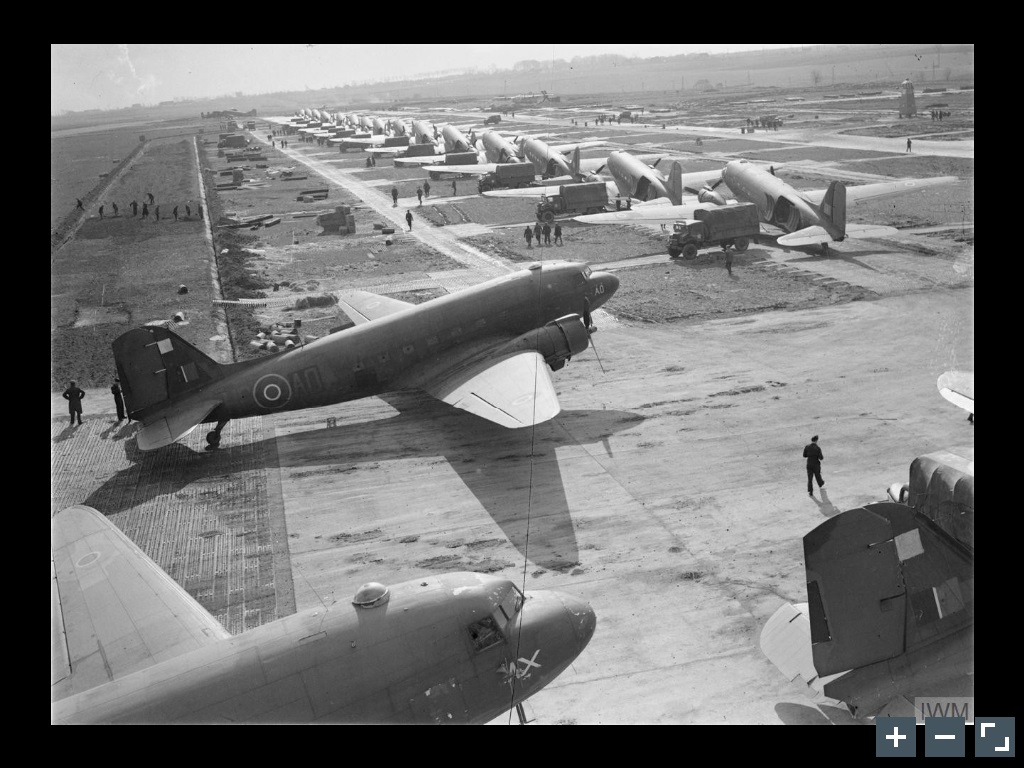
Lorem ipsum dolor sit amet, consectetur adipiscing elit. Ut elit tellus, luctus nec ullamcorper mattis, pulvinar dapibus leo.
Hits: 1641
